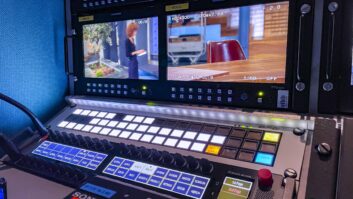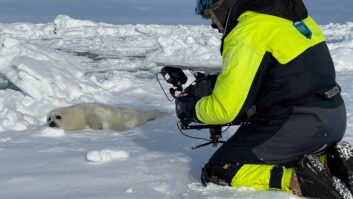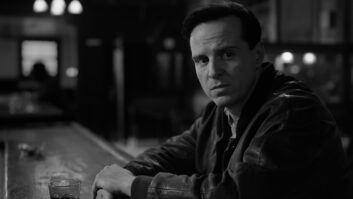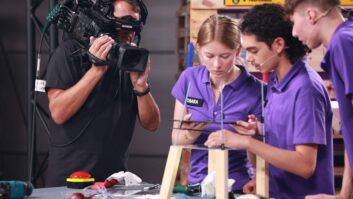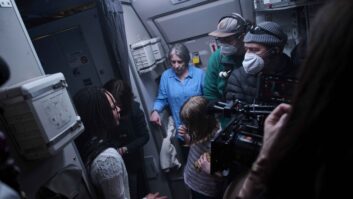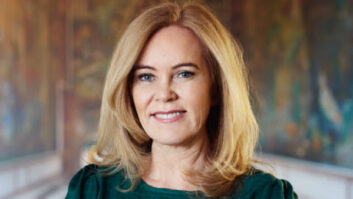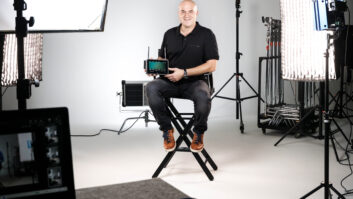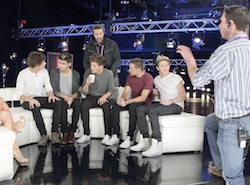
Europe’s first Sony HD Studios has launched at Irish commercial television broadcaster TV3 Group in Dublin. Fergal Ringrose attended the opening.
TV3 Group’s Sony HD Studios Dublin launched in March, in what is believed to be the first Sony-branded TV studio space in Europe. At 5,000 sq ft it stands as the biggest purpose-built HD TV studio in Ireland, accommodating a seated audience of up to 200.
TV3 hopes that the studio will become a centre for in-house production; a production hub for Irish and international companies; creative centre for ad agencies; and a media facility for corporate training events. TV3’s own flagship current affairs show, Tonight With Vincent Browne, was first to be broadcast from the studio last month – while the first third-party production to take place was a half-hour programme on One Direction, the world’s biggest boy band, for Sony Music Entertainment Ireland.
At the launch event TV3 CEO David McRedmond said “six years ago, shortly after UK investment house Doughty Hanson acquired TV3 and I came in as a new CEO we met with Eamon Ryan, the Minister for Communications.
“I and my Doughty Hanson colleagues told him that we wanted to transform TV3 from a broadcaster with a largely foreign schedule into a national broadcaster of Irish programming. We wanted Government to reform the market so that commercial broadcasting would have a fair shake and in return we would invest in TV3 as an Irish broadcaster.
“Six years later, despite the worst recession in history and a market crash in advertising, we are still here but with a difference. In 2010, as Doughty Hanson had to re-finance the business to get it through another savage year, they set aside €4.5m to build this studio because of their and our commitment to creating the best Irish content. Of course being a broadcaster I slightly overspent!
“My colleague [TV3 commercial director] Pat Kiely had the great idea to enter into a partnership with Sony to ensure we had the very best equipment and they fell into the enthusiastic embrace of this extraordinary project. So together Sony, Doughty Hanson and with a little work from ourselves we have built this, one of the most advanced and best television studios in Europe.”
The Republic of Ireland has a highly unusual commercial television broadcasting landscape, in that public broadcaster RTÉ is dual-funded through advertising revenue and a licence fee. TV3 never sees a penny of this licence fee. Instead it has to compete in a distorted marketplace where its main competitor can cross-subsidise if it falls short or overspends in any way that would simply be catastrophic for a stand-alone commercial competitor.
Against that background, in a challenged market through a brutal six-year Irish recession, the decision to press ahead with the new studio shows both remarkable fortitude and confidence on the part of TV3’s owners and management. As director of Broadcasting Niall Cogley told us, “it was brave. It was a difficult time to do it. If there’s an upturn, it positions us very well in terms of both the commercial market and also our own productions. It would be a nice problem to have if we’ve too much content and not enough studio space!”
Technology and suppliers
Following the launch event, TVBEurope visited the new studio and spoke to chief engineer Jose de Freitas about its technology journey. “We’ve been doing eight hours programming a day at TV3, from one very small studio – with 12-year old equipment. So as a company we decided we needed another space.
“We spent a lot of time looking at revamping the existing studio or possibly carving out some space in the existing building – but nothing made sense,” he said. “In the business park here there were a couple of empty buildings; the landlord of both buildings is the same, so then it became possible to start looking at these options.”
When TV3 launched and went on air in 1998 it did so with a turnkey solution from Sony. That long-standing relationship continued through various upgrades and replacements during subsequent years. So naturally Sony was in the frame to supply equipment for the proposed new studio – but it was not the only bidder for the contract. Instead, the naming-rights deal for a three-year period was hammered out between TV3 and Sony to enable the project to come to fruition.
“We could become a kind of showpiece in Europe. And that’s one of the things we committed to with Sony, that they can use us as an example and we will open our facilities for those things including possible equipment demonstrations or other events,” said de Freitas.
“It’s interesting that we’ve actually extended beyond the Sony Broadcast group already,” added head of Broadcast Resources Paul Daniel. “For instance it was through Sony Music that we had One Direction to film the very first item in the studio. That worked for Sony as they were able to go online and say ‘filmed at Sony HD Studios in Dublin’, so it worked out really well for both parties.”
“The building blocks of the studio were supplied by Sony through Eurotek,” said de Freitas. These included six Sony HDC-2400 cameras, an MVS-7000X vision mixer and seven professional Trimaster OLED monitors – along with Canon HD lenses, Vinten Quartz peds and Vector heads, Autocue prompting and Beyer DT-109/8 headsets.
“The Sony deal was half of the project: cameras, vision mixer, peds, lenses and autocue. We then added the
, audio desk, cap gen and all of the glue. For that we worked with BVS and Tyrell; they were the suppliers of the other half of the project.”
A Harris multiviewer through BVS was a logical choice as Zandar technical support staff are still based in Dublin (following Harris’ purchase of the Zandar business in 2008). Avid cap gen and the remaining gallery screens (standard Sony home 55-inch TVs) were supplied through Tyrell. TV3 chose a Studer Vista 5 audio console (just edging out Calrec Artemis Light) with a 42-channel control surface and four stage boxes, supplied through Tyrell, along with Genelec audio monitoring through BVS.
“Talkback is Clear-Com,” said de Freitas. “We did the talkback deal last year. That has provided a very seamless connectivity between the two buildings and we just fibred them up. The dealer for Clear-Com in the UK and Ireland is Tyrell.
“We did the same thing with the main video router; 18 months ago we needed to refresh the old building and part of the BVS deal was that the router for this studio would be exactly the same – Snell — and we just put some fibre tielines between the two.”
The design and configuration of the studio, gallery and CAR was by TV3’s team, with the physical wiring and termination undertaken by BVS. “Most of the decisions on lighting infrastructure were also made by us,” said de Freitas, “and we used Cine Electric as main supplier of lighting equipment. I wanted to involve as many Irish companies as I possibly could in the process. This is one of our underlying philosophies, that we do support the local dealers as much as possible.”
Access and opportunity
“Everything is connected into the existing building so that any uplinks or fibre connectivity or taking down satellite feeds can be done,” said de Freitas. “It’s not just a remote studio; it’s a broadcast facility. It is a TV station. And we’ve two channels, so we have quite a bit of freedom in how we schedule things – that’s another compelling reason to come here.”
“Back in 1998 when TV3 was opened it was kind of regarded as being out of the way,” added Daniel. “Now it’s on the major motorway [the M50], 15 minutes from Dublin airport, with fantastic access and parking so it has become a valuable destination for production. For instance if you can’t shoot in London and you’re looking at Manchester – it’s not much of a stretch just to come to Dublin. That’s something that we’re actively chasing.”
“We’re going to be focusing on the UK and specifically on London in terms of our next round of sales,” confirmed Cogley. “RTÉ have been here, all the Irish production companies have been here to see it and understand its possibilities. Two have already decided to come here to make programme series.
“Every TV person who has come here has said, ‘OK we can see that all the decisions have been made here on behalf of television people.’ You can back up your sets and your lights into here and there will be no delay,” said Cogley. “It is designed for broadcasters by broadcasters. We still have our existing space, so we’re happy to make compromises for incoming partners if their needs are such.
“We are saying Dublin is now as good as anywhere else ‘in the UK’ for production,” he said. “Some productions are just too big for us; if they want 600 people in the audience to get that texture, we won’t pretend we can cater for them. But the general sense we get from all of the people we’ve spoken to around London is enthusiasm. And there’s a very high skill level here. There are a lot of very experienced broadcast professionals here in Dublin.”
